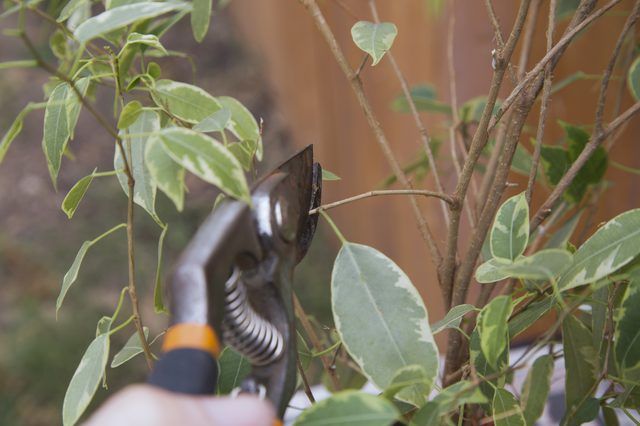Bulbs
Flower Basics
Flower Beds & Specialty Gardens
Flower Garden
Garden Furniture
Garden Gnomes
Garden Seeds
Garden Sheds
Garden Statues
Garden Tools & Supplies
Gardening Basics
Green & Organic
Groundcovers & Vines
Growing Annuals
Growing Basil
Growing Beans
Growing Berries
Growing Blueberries
Growing Cactus
Growing Corn
Growing Cotton
Growing Edibles
Growing Flowers
Growing Garlic
Growing Grapes
Growing Grass
Growing Herbs
Growing Jasmine
Growing Mint
Growing Mushrooms
Orchids
Growing Peanuts
Growing Perennials
Growing Plants
Growing Rosemary
Growing Roses
Growing Strawberries
Growing Sunflowers
Growing Thyme
Growing Tomatoes
Growing Tulips
Growing Vegetables
Herb Basics
Herb Garden
Indoor Growing
Landscaping Basics
Landscaping Patios
Landscaping Plants
Landscaping Shrubs
Landscaping Trees
Landscaping Walks & Pathways
Lawn Basics
Lawn Maintenance
Lawn Mowers
Lawn Ornaments
Lawn Planting
Lawn Tools
Outdoor Growing
Overall Landscape Planning
Pests, Weeds & Problems
Plant Basics
Rock Garden
Rose Garden
Shrubs
Soil
Specialty Gardens
Trees
Vegetable Garden
Yard Maintenance
How to Trim a Ficus Tree
How to Trim a Ficus Tree. Ficus trees, among about 850 plants in the Ficus genus, may be more familiar by their common names including weeping fig (Ficus benjamina), hardy in U.S. Department of Agriculture plant hardiness zones 10 through 12 and rubber tree (Ficus elastica), hardy in USDA zones 10 through 11. Trimming or pruning a ficus tree...
Ficus trees, among about 850 plants in the Ficus genus, may be more familiar by their common names including weeping fig (Ficus benjamina), hardy in U.S. Department of Agriculture plant hardiness zones 10 through 12 and rubber tree (Ficus elastica), hardy in USDA zones 10 through 11. Trimming or pruning a ficus tree benefits the plant in several ways. Not only does it help control the shape and size of the tree, it promotes new growth. By removing any dead or diseased branches, it increases air circulation and allows more light to reach inner foliage. Although outdoor hardiness zones differ by specific variety, these tropical plants do well in protected, frost-free areas outdoors or grown inside containers.
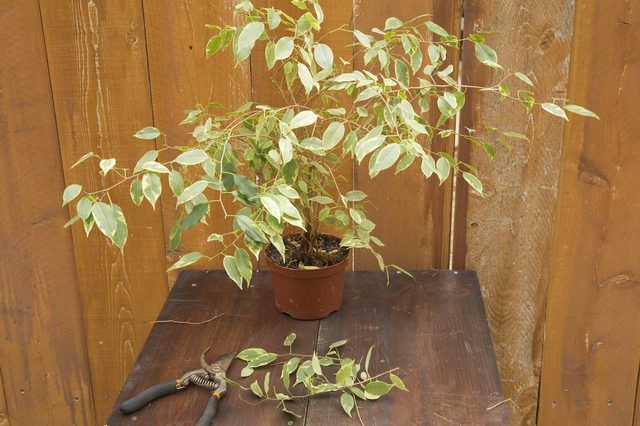
Things You'll Need
Newspaper
Pruning shears
Alcohol wipes (optional)
Ten-percent bleach solution (optional)
Garden gloves (optional)
Step 1
Trim your ficus tree any time of the year, however the best time is during the plant's rest period between growth spurts. Look for new leafy shoots on the tree as a signal that it is time to prune. For indoor trees, this usually occurs during the spring.
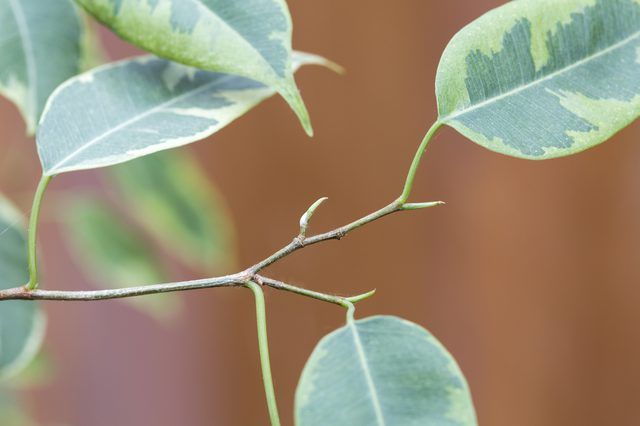
Step 2
Make sure your pruning shears are sharp. Dull shears can tear the branches and leave them vulnerable to infections and disease. Wipe the blades of your shears with alcohol wipes between pruning cuts to avoid spreading disease. You can also mix nine parts water and one part household liquid bleach in a bucket, and dip the blades into the solution between snips to disinfect them.

Step 3
Cover the work area with newspaper if you are trimming the ficus indoors. Ficus branches often drip sap after being trimmed.

Step 4
Locate the branch collar on any branches you are considering trimming. The branch collar is the enlarged area at the base of the branch where it joins the stem. All cuts should be made at a slight angle so the cut terminates at the outside edge of the branch collar.
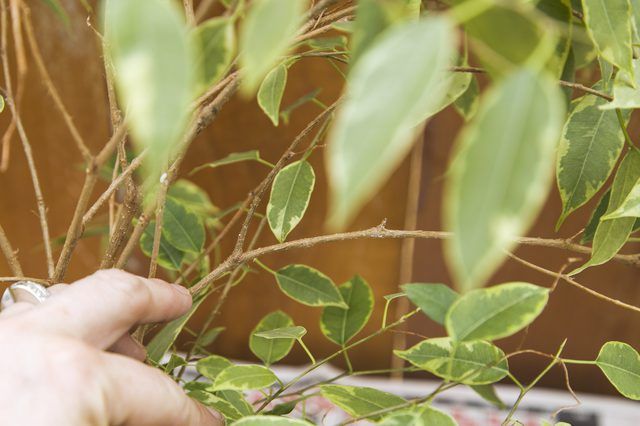
Step 5
Thin the tree by trimming back large limbs to a new bud or young shoot instead of trimming all the branches equally. Thinning helps balance the tree, and it opens the limb framework to improve light penetration.
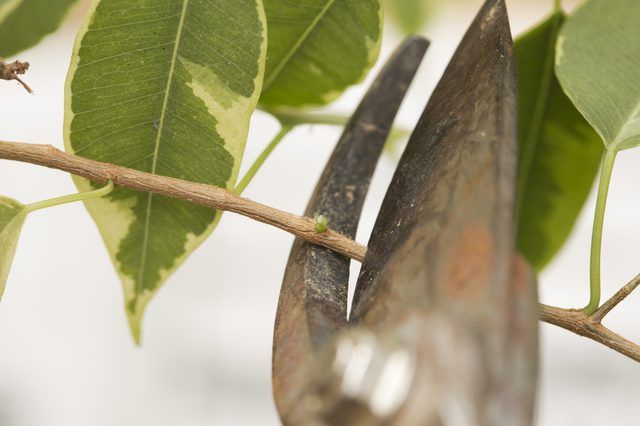
Step 6
Remove any dead, diseased or pest-infested branches first. Because they may reinfect your plants, don't add them to a compost pile. Dispose of them in a trash collection container.
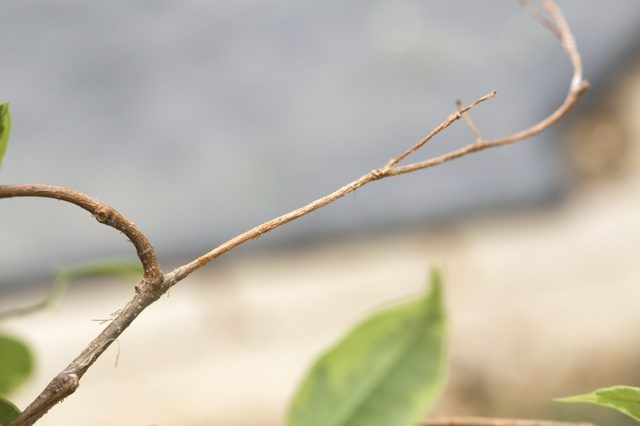
Step 7
Remove any crowded branches, branches that rub or cross and branches that grow inward. Improve the tree's form by pruning back branches that compete with the main leader as well as any branches that you feel disfigure the tree.
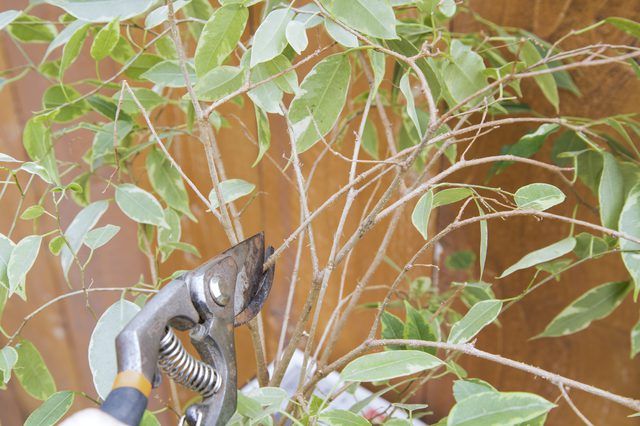
Step 8
Trim a branch back to a leaf node or bud to make it grow in a different direction. The new branch grows in the direction the leaf node or bud faces.
